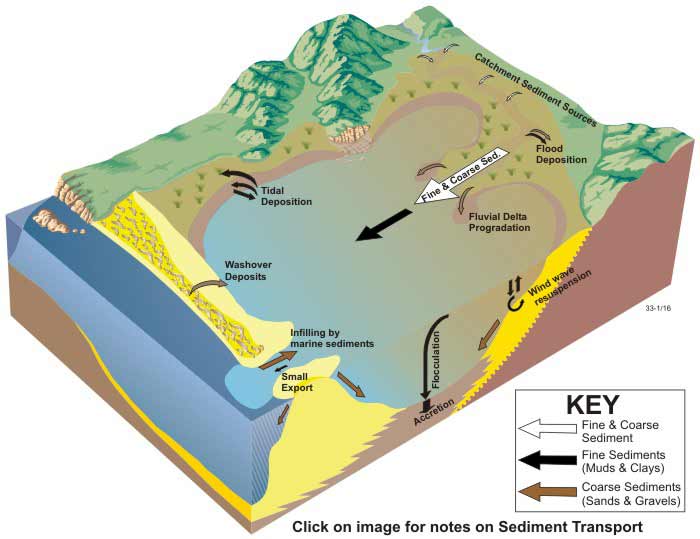
Sediment transport processes in wave-dominated estuaries
1. Fine and coarse sediment input from the catchment
Fine and coarse sediment enters the estuary from the catchment. The amount of sediment input varies regionally, depending on catchment and climatic conditions, and the volume of freshwater input. However, the amount of terrigenocatus sediment delivered to wave-dominated estuaries is usually relatively large.
2. Deposition of coarse material
Coarse sediment (i.e., gravels and sands) is deposited at the head of the estuary forming a fluvial bayhead delta that, unless disturbed by waves, progrades into the central basin. Terrigenous sediment from the catchment is supplied by rivers and mostly deposited in the fluvial deltas, although some of the fine load may be transported to the central basin (Webster et al., 2002, Pasternack et al., 2002).
3. Fine sediment accumulation
Fine sediment (i.e., muds, clays, and organic material) is deposited on the fringes of the central basin by river processes, tides, and internally generated waves. Deposition in these environments is aided by the baffling effects of vegetation such as saltmarshes and mangroves (Boorman et al., 1998, Brown, 1998, Saintlan et al., 1999, Temmerman et al., 2003, Laegdsgaard, 2001). Coarse sediment (i.e., sands and gravels) may also accumulate in the fringing environments during floods. Biological activity and waves cause significant reworking of fine sediment on un-vegetated intertidal flats.
4. Transport of fine material into the central basin
Suspended sediment is transported into the central basin, where it is deposited in a low-energy environment. Flocculation, or particle aggregation due to changes in salinity, is also an important process that enables fine particles to settle out from the water column. Benthic micro-algae (BMA) assist in the stabilisation of fine sediment (Wulff et al., 1997, Cahoon et al., 1999, Murray et al., 2002). Seagrasses, where present, also promote sedimentation and stabilise the substrate (Moriarty et al., 1985). The low-energy conditions, and large relative size of the central basin means that this region is the primary repository for fine material and particle-associated contaminants (Hodgkin et al., 1998, Heggie et al., 1999b, Heap et al., 2001, Harris et al., 2002). Resuspension of the fine sediment can occur in wave-dominated estuaries with either very shallow central basins or a lack of stabilising vegetation, causing significant turbidity.
5. Tidal infilling by coarse marine sediments
At the entrance, tidal currents are locally accelerated in the constricted entrance, and form flood and ebb tidal deltas (Roy, 1984a). Sedimentary processes are dominated by the landward transport of coarse sediment derived from the marine environment (Green et al., 2001). Sediment can be exported to the ocean through the inlet, particularly during spring tides and flood events (Harvey, 1996).
6. Washover during storm events
Coarse marine sediment is driven along the coast by strong wave energy and is deposited as a supra-tidal (subaerial) barrier, and tidal deltas at the entrance (Melville, 1984, Otvos, 2000, Roy et al., 2001). During storms, large waves transport sediment over the barrier and form washovers that extend into the central basin. Marine sediment is transported into the estuary by aeolian, tidal, and wave processes, forming a sandy barrier and washover deposits that also may extend into the central basin (Boyd et al., 1992).
7. Export of fine sediments into the marine environment
The sediment trapping efficiency of wave-dominated estuaries is very high because sediment from the catchment and marine sources is trapped in the low-energy central basin, which may capture up to 80% of fine sediment (Patchineelam et al., 1999, Roy et al., 2001). Infilling by marine sand transported through the entrance can also be a significant source of sediment in immature wave-dominated estuaries.


